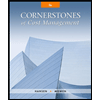
1.
Transfer price: Transfer price is the price at which goods and services are transferred between divisions or centres in an organization. The price charged to transfer goods and services is recorded as an expense in the buying division and revenue in the selling division.
- The lowest transfer price acceptable by A Division.
- The highest transfer price acceptable by B Division.
- The range of acceptable transfer prices. Also, determine whether the managers probably agree to a transfer.
2.
Transfer price: Transfer price is the price at which goods and services are transferred between divisions or centres in an organization. The price charged to transfer goods and services is recorded as an expense in the buying division and revenue in the selling division.
- The lowest transfer price acceptable by A Division.
- The highest transfer price acceptable by B Division.
- The range of acceptable transfer prices. Also, determine whether there is any disagreement between the managers related to the transfer price.
- The loss in potential profits of the company as a whole.
3.
Transfer price: Transfer price is the price at which goods and services are transferred between divisions or centres in an organization. The price charged to transfer goods and services is recorded as an expense in the buying division and revenue in the selling division.
- The lowest transfer price acceptable by A Division.
- The highest transfer price acceptable by B Division.
- The range of acceptable transfer prices. Also, determine whether the managers agree to transfer.
- Whether the return on investment of the A division increases, decreases, or remains unchanged.
4.
Transfer price: Transfer price is the price at which goods and services are transferred between divisions or centres in an organization. The price charged to transfer goods and services is recorded as an expense in the buying division and revenue in the selling division.
The lowest transfer price acceptable by A Division.
Want to see the full answer?
Check out a sample textbook solution
Chapter 11 Solutions
MANAGERIAL ACCOUNTING-W/ACCESS >C<
- The direct materials cost per pound for both years was $0.09 per pound.arrow_forwardCan you demonstrate the accurate method for solving this financial accounting question?arrow_forwardMarch, April, and May sales are $80,000, $95,000, and $110,000, respectively. 15% of sales are collected in the month of sale; 60% are collected in the month following sale, and the remaining 25% are collected in the second month following sale. What is the amount of cash collections in May? Show steps used in solving the problem. A. $118,500 B. $25,000 C. $93,500 D. $115,000arrow_forward
- I am looking for the correct answer to this financial accounting problem using valid accounting standards.arrow_forwardThe insurance company reimburses MHC on a fee-for-service basis, with an average reimbursement rate of $12,000 per admission.arrow_forwardI need help with this general accounting problem using proper accounting guidelines.arrow_forward
- Salvador Manufacturing estimates that annual manufacturing overhead costs will be $842,400. Estimated annual operating activity bases are direct labor costs of $496,000, direct labor hours of 41,200, and machine hours of 90,400. Compute the predetermined overhead rate for each activity base: a. Overhead rate per direct labor cost b. Overhead rate per direct labor hour c. Overhead rate per machine hourarrow_forwardI need help in this question . accounting.arrow_forwardNeedarrow_forward
 Cornerstones of Cost Management (Cornerstones Ser...AccountingISBN:9781305970663Author:Don R. Hansen, Maryanne M. MowenPublisher:Cengage Learning
Cornerstones of Cost Management (Cornerstones Ser...AccountingISBN:9781305970663Author:Don R. Hansen, Maryanne M. MowenPublisher:Cengage Learning Managerial Accounting: The Cornerstone of Busines...AccountingISBN:9781337115773Author:Maryanne M. Mowen, Don R. Hansen, Dan L. HeitgerPublisher:Cengage Learning
Managerial Accounting: The Cornerstone of Busines...AccountingISBN:9781337115773Author:Maryanne M. Mowen, Don R. Hansen, Dan L. HeitgerPublisher:Cengage Learning

